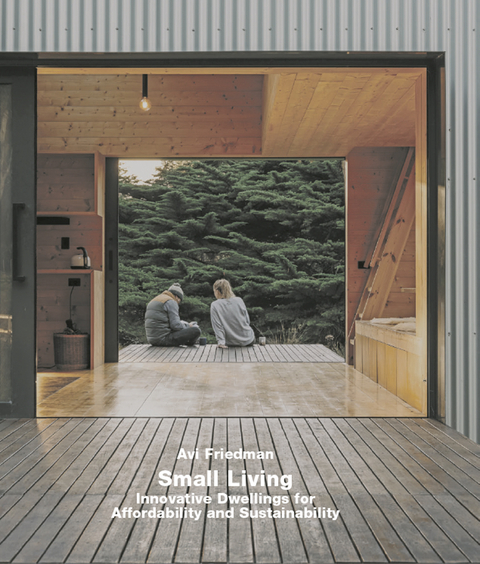
Small Living. Innovative Dwellings for Affordability and Sustainability
Seiten
2025
Edition Axel Menges (Verlag)
978-3-86905-043-0 (ISBN)
Edition Axel Menges (Verlag)
978-3-86905-043-0 (ISBN)
- Noch nicht erschienen (ca. Februar 2025)
- Versandkostenfrei innerhalb Deutschlands
- Auch auf Rechnung
- Verfügbarkeit in der Filiale vor Ort prüfen
- Artikel merken
In recent decades demographic shifts have significantly
influenced young peoples’ residential preference.
Due to the rise of single-person households,
smaller family sizes, and the desire for lower maintenance
and utility costs, many young individuals
are choosing to live in smaller, efficient spaces in
proximity to work and urban amenities. These
changes have led to an increase demand for multi-
functional, space-efficient designs.
As people’s daily routines and expectations
evolve, the design of living spaces must adapt accordingly.
The need for multifunctional rooms has
become apparent; a living room that seamlessly
transitions into a home office represents just one
of the many adaptations that modern dwellers require.
Architects, interior designers, and homebuilders
are responding with innovative solutions
like convertible furniture, built-in storage, and
open-plan layouts that facilitate a compact but
comfortable living environment.
An often-discussed notion in design and construction
is sustainability. Its origin and widespread
use of the term sustainable development can be
attributed to events and circumstances that occurred
several decades ago. The 1992 United Nations
Conference on the Human Environment in
Stockholm addressed concerns regarding humanity’s
potential overuse of the earth’s »carrying capacity«.
As people’s awareness of protecting our living
environment increases, the choice of smaller
homes is becoming a more common and environmentally
responsible decision. This shift is driven
by the need to reduce resource consumption, as
smaller homes require fewer materials for construction,
maintenance, and repairs. Moreover, smaller
homes are inherently more energy-efficient due to
their reduced space, which requires less energy for
heating and cooling. Additionally, the smaller footprint
means using less land per dwelling unit.
influenced young peoples’ residential preference.
Due to the rise of single-person households,
smaller family sizes, and the desire for lower maintenance
and utility costs, many young individuals
are choosing to live in smaller, efficient spaces in
proximity to work and urban amenities. These
changes have led to an increase demand for multi-
functional, space-efficient designs.
As people’s daily routines and expectations
evolve, the design of living spaces must adapt accordingly.
The need for multifunctional rooms has
become apparent; a living room that seamlessly
transitions into a home office represents just one
of the many adaptations that modern dwellers require.
Architects, interior designers, and homebuilders
are responding with innovative solutions
like convertible furniture, built-in storage, and
open-plan layouts that facilitate a compact but
comfortable living environment.
An often-discussed notion in design and construction
is sustainability. Its origin and widespread
use of the term sustainable development can be
attributed to events and circumstances that occurred
several decades ago. The 1992 United Nations
Conference on the Human Environment in
Stockholm addressed concerns regarding humanity’s
potential overuse of the earth’s »carrying capacity«.
As people’s awareness of protecting our living
environment increases, the choice of smaller
homes is becoming a more common and environmentally
responsible decision. This shift is driven
by the need to reduce resource consumption, as
smaller homes require fewer materials for construction,
maintenance, and repairs. Moreover, smaller
homes are inherently more energy-efficient due to
their reduced space, which requires less energy for
heating and cooling. Additionally, the smaller footprint
means using less land per dwelling unit.
Avi Friedman received his Bachelor’s degree in architecture and town planning from the Israel Institute of Technology, his Master’s degree from McGill University, and his Doctorate from the University of Montréal. At McGill, where he is a full professor, he cofounded the Affordable Homes Program. He also holds a visiting professor position in Lancaster University in the UK. He is the author of 25 books, the principal of Avi Friedman Consultants Inc. and the recipient of numerous awards including the Lifetime Achievement Award from Sustainable Buildings Canada and the World Habitat Award. In 2000 he was selected by Wallpaper magazine as one of ten people from around the world »most likely to change the way we live«.
| Verlagsort | Stuttgart |
|---|---|
| Sprache | englisch |
| Maße | 233 x 285 mm |
| Themenwelt | Technik ► Architektur |
| Schlagworte | kleine Häuser • kleine Wohnungen • Nachhaltigkeit • Umweltfreundlich leben |
| ISBN-10 | 3-86905-043-8 / 3869050438 |
| ISBN-13 | 978-3-86905-043-0 / 9783869050430 |
| Zustand | Neuware |
| Informationen gemäß Produktsicherheitsverordnung (GPSR) | |
| Haben Sie eine Frage zum Produkt? |
Mehr entdecken
aus dem Bereich
aus dem Bereich
Grundlagen, Normen, Vorschriften
Buch | Hardcover (2024)
Springer Vieweg (Verlag)
159,99 €
Traditionelle Bautechniken in Europa, Japan und China
Buch | Hardcover (2023)
Birkhäuser (Verlag)
68,00 €
Vom Rohmaterial zum Bauwerk. Ein Handbuch
Buch | Softcover (2022)
Birkhäuser Verlag GmbH
68,00 €


